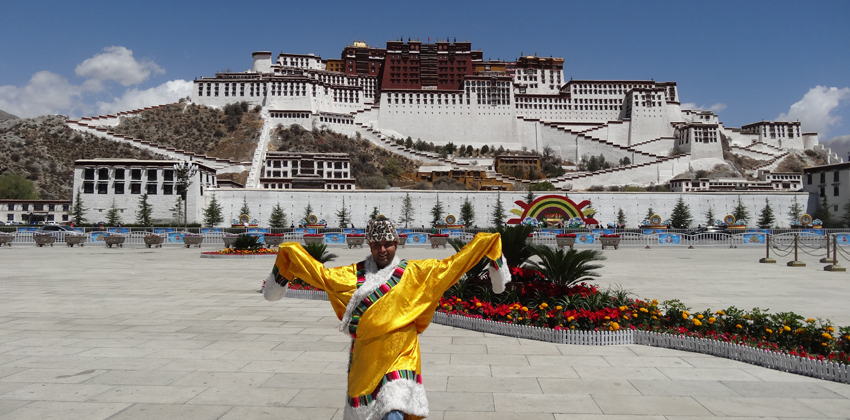
Arriving in Kathmandu 13 April 2013, after the flight from Sydney via Kuala Lumpur, I was met by Rishi who runs EncountersNepal.com. After the vibrant marigold garland of welcome had been placed around my neck and refreshments had been taken at Hotel Holy Himalaya in Thamel where I was to be based for the next month, it was straight down to serious Tibet visa application business.
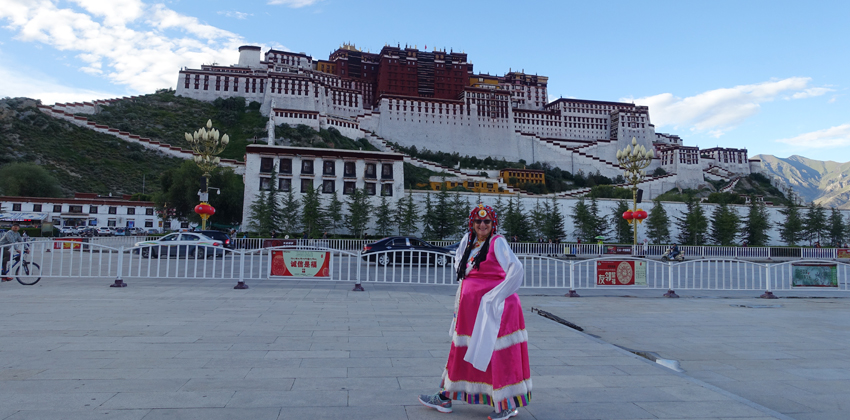
On 29 March 2013, just two weeks prior to my departure from Sydney, the very obstructionist restrictions imposed by Beijing on tourist visas to the autonomous region of Tibet had been fortuitously revised. During 2012, a minimum of five people, all of exactly the same nationality, had to be travelling in a group in order to be eligible for consideration for the provision of a tourist visa. Suddenly from the end of March 2013, it was possible to visit Tibet as long as you had a minimum of two people travelling together, irrespective of their nationality.
Seizing the opportunity, I had advised Rishi before I left Sydney that I would like him to organize a short tour, so that I could at least experience a little taste of Tibet on this trip. In September 2012, when I had last come to Nepal, because of the egregious visa restrictions, I was both frustrated and disappointed that I had been unable to visit Tibet. I therefore had organized a trip through the mountains of Sichuan and Yunan in southwestern China which included visiting some of the Tibetan communities in these regions as an alternative arrangement, before traveling to Nepal to do some English teaching and trekking.
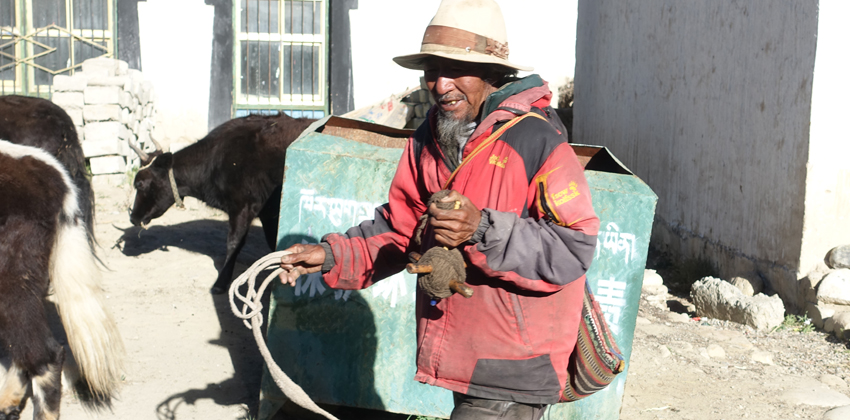
Immediately after arrival and after my passport sized photos had been handed over, Rishi, dashed off to lodge my visa application. Fortunately, he had agreed he would make up the second person in my group so that I could get actually get to Tibet during this visit to the region. The planned four day tour of Lhasa would commence 27. April 2013. Prior to this, I would be spending six days in Bhutan.
Here is an extract that I composed shortly after returning to Nepal after the four days away, looking “for” and looking “at” Lhasa!
Back in the balmy Kathmandu Valley situated at a mere 1600 metres above sea level for just over 48 hours, I can feel a warm surge of full strength oxygen uptake happily coursing around all the cells that make up me. Whether this is due to the sheer familiarity of the place which greets me from the moment I set foot into the sweaty fug inside the dilapidated hall of the Tribuhven International Airport, or more prosaically, the increased density of oxygen molecules present in the prevailing, albeit smog - laden, atmosphere, who knows?
Here in Kathmandu, the cacophonous horns are still tooting, the roads are still jumbled, rutted, dusty thoroughfares for humans, cows, chickens and sundry dilapidated motor vehicles and rickshaws and about the only glimpse of gleam in sight is hidden in the promise held in my toothpaste. There is the odd verandah with intricately carved beams being built onto a building façade here and there, but there does not appear to be terribly much happening in terms of proliferating public infra - structure.
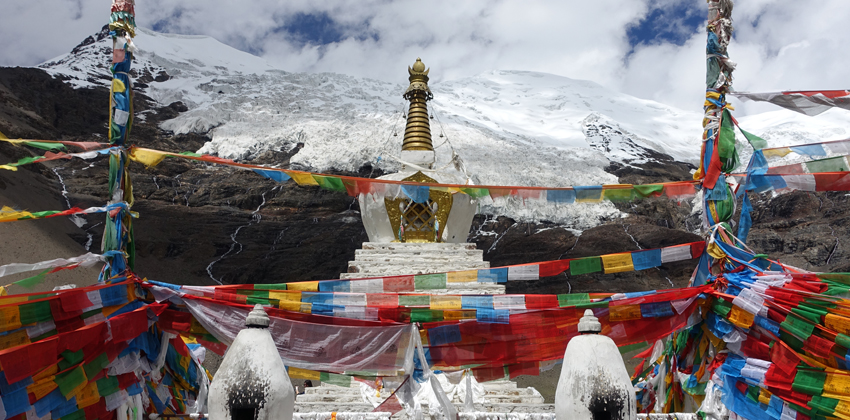
Not so in Lhasa! Lhasa is an excavated, rubble filled, pipe strewn work in progress. The streets and footpaths of central Lhasa are a mess, but unlike Kathmandu, not due to poverty and neglect, but due to massive construction works being undertaken: a subway, the supply of a central heating system to all buildings in the inner city, the enhancement of the windows and facades of all the shops and dwellings in the main market precinct. The road which leads from the Gonggar Airport situated at Gyazuling, approximately 50 kilometres out of town, is a divided four lane expressway with expertly engineered tunnels bored into the mountains to expedite the travelling time between the airport and the city.
This is all well and good, but actually making arrangements to gain entry and then ensuring you actually set foot on the sacrosanct ground of this sacred city sets you off on an uncertain and adrenaline charged mission. This exciting uncertainty lasts from the moment the thought that you wish to travel to Lhasa enters your mind and only dissipates upon arrival when your waiting local guide ceremoniously dons you with the traditional white kata around your shoulders, uttering "Welcome to Tibet!" Once you have stepped outside the terminal into the bracing thin air, you can be certain you have at last reached your destination!
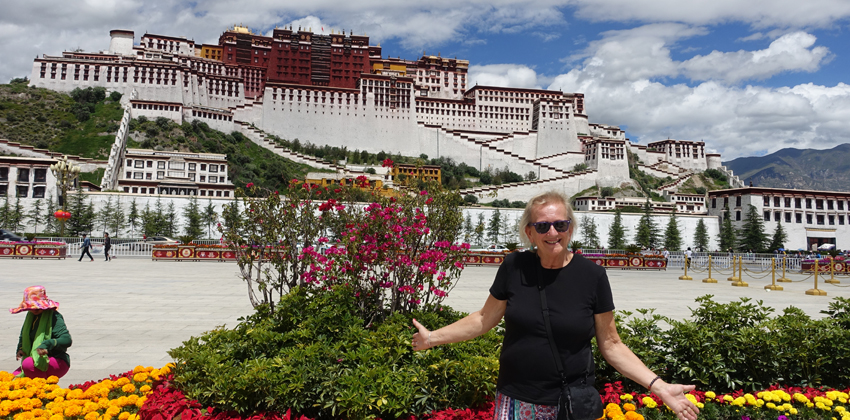
In my case, the flight left Kathmandu pretty much on schedule, in contrast to the four hour delay the previous Saturday to fly to Paro in Bhutan. The visa for Tibet had been granted and delivered a full 24 hours prior to departure. Reassuring. So far everything was going well. Even though I had paid up for this excursion weeks previously, I am told you always sit in a cloud of uncertainty as to whether the Chinese will actually grant you the required visa. The start of the teeth chattering adventure into this mystical land is preparing the visa application form and handing it over.
Once again, the flight path provided a whole hour of astounding snow bedecked Himalayan peak views. During the "55 minute" flight, I chomped on Air China sesame coated peanuts and quaffed down “Tibetan Springs” water, fully expecting to be landing in Lhasa on time. Suddenly, we were no longer descending but appeared to be gaining altitude as further magnificent white ranges and icing sugar coated caterpillar chains of bare brown hills opened up before us. An announcement came through the cabin.
"Due ro bad reather in Raasa, we now frying staight Chengdu. In Chengdu tempture now 32 delglee!"
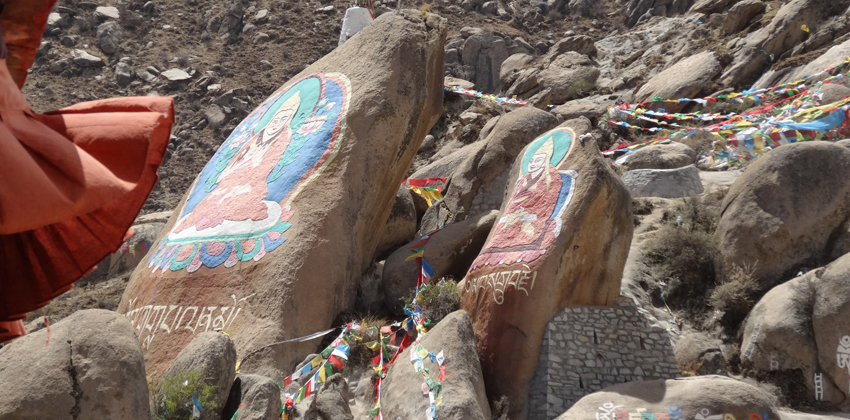
Great. You have the visa, the plane leaves according to the timetable and you are looking forward to a pleasant four days of initiation to the architectural, spiritual, cultural and geographic wonders of Lhasa. Suddenly, I am thinking of the money spent last September to have 52 kilos of Chengdu infant panda lounge in my lap for a few minutes and I begin to reflect on the irony of how I could have saved on that and had an extra 15 days in Tibet now! A detour to Chengdu on a four day trip to Lhasa provides an interesting diversion from the planned route, but definitely makes inroads into the time available for the introductory Tibet experience.
That was the end of my journal entry from that time.
The arrival in Chengdu, after by-passing Lhasa, was most entertaining! Non Mandarin speaking passengers on our flight had no idea what the plan of action was to be. We disembarked in the hot late afternoon air. Would we sit around the terminal for a while and then be flown back to our real destination sometime later in the evening? Why weren’t we in Lhasa anyway? Where might we be taken next?
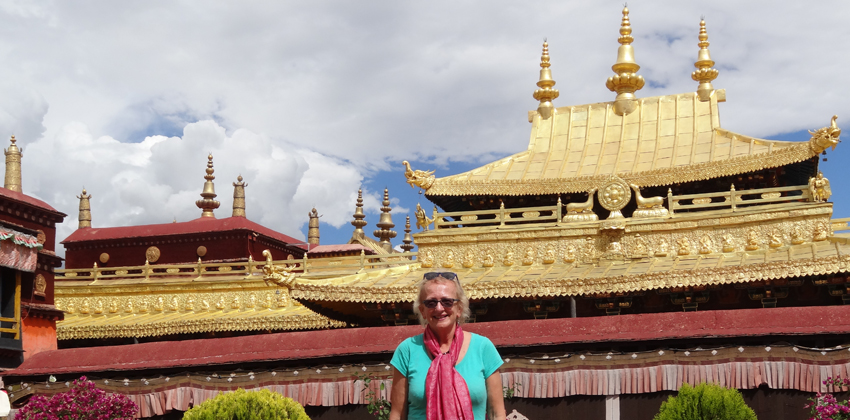
As we paraded more or less in single file through the secure part of the terminal, the only guidance worth anything to us, was the occasional shrill call, “Lhasa, Lhasa!” uttered by earnest looking airport employees at various strategic points to indicate where we passengers, destined for Lhasa, Tibet’s capital, but now in the capital of Szechuan, should head next.
Somehow slowly, the message percolated through the international non Chinese speaking collection of passengers who had been on our plane, that those destined for Lhasa were to be accommodated in a hotel for the night.
It was thus that we were herded onto a bus that headed through the orderly streets surrounding the very new Shuangliu International Airport, Chengdu for approximately 15 minutes to the Datong Shiji Hotel, 7 kilometres away. A senior father and adult son from Chicago doubted the story about a sudden change in the weather from having prevented us from landing in Lhasa. Instead of a sandstorm created by sudden gale force winds, they attributed our plane’s diversion to more sinister political reasons. They also thought that repeatedly voicing their accommodation request, “ONE ROOM, TWO PEOPLE”, in ever increasing volume to the hard working smiling female reception staff who had a very rudimentary smattering of some basic English pertaining to accommodation requests, would secure just the right room for them. Indeed it did not… as the staff had already understood their request, as anyone who actually stood still for half a minute and noted their gestures and words, would have comprehended. It was a comically archetypal situation to observe.
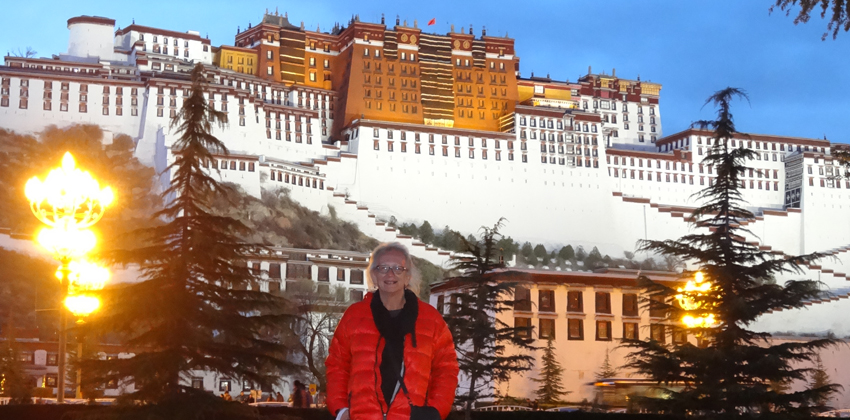
It was indeed altogether a fun night with none of the foreigners from our plane able to speak Mandarin and none of the staff having command of any European language. In spite of all this, or perhaps because of this, we enjoyed with much amusement a delicious vegetarian buffet dinner and a walk along the street outside in the warm night air. It felt safer to stroll around the hotel than to risk taking a taxi somewhere, to who knows where, and, due to the language difficulties, to not make it back to the hotel in time for the next connecting flight back to Lhasa.
Early the next morning before 5.00am and whilst it was still dark, we boarded the bus outside the hotel to be returned to the airport for an early flight back to Lhasa from Chengdu. The flight from Kathmandu to Lhasa is the only international air route into Tibet. Chengdu – Lhasa is a “domestic” flight, the “Autonomous Region of Tibet” being part of China, obviously.
Perman, our young guide was enthusiastically waiting outside the terminal (elevation 3700 metres) with a wide, white smile. Not only did he have no idea what was happening with us the whole afternoon he had been waiting the previous day for our plane to arrive, he was not at all certain we would turn up even now on Sunday morning. He just seemed happy that his guests had materialized at last and so welcomed us in the traditional way by placing long white scarves around our shoulders.
It was this initial smooth approximately 45 minute drive ride along the freeway into the centre of Lhasa that made the first strong impression. Passing steep, bare “hills” that loomed up on all sides, and crossing the Bramaputra River, also known as the Yarlung Tsangpo, which merges with the Ganges and flows into the Bay of Bengal, I felt that, despite the harsh mountainous environment, modern engineering and a comfortable vehicle had made the transit an easy and painless feat!
First stop was Jokhang Temple in Barkhor Square, built with Indian, Chinese and Nepalese influences, originally 642. Standing on the roof in the brilliant late morning sun, I was dazzled by the sight of the iconic Potala Palace set against the backdrop of undulating desolate snow crowned mountains.
Not far away is a little restaurant, the “New Mandala”. With views from the rooftop across the city to the mountains and of bright prayer flags fluttering alongside electric wires, eating curries and naan and drinking lassies was just such a pleasure, even if the poor waitress looked run off her feet repeatedly descending the stairs back to the kitchen to carry up the goodies for the lunchtime clientele. Somehow just having this outlook over the busy main square where construction work was in full swing in stark contrast to the nearby sedately peaceful monasteries and temples, where thus the new and the old was all intermingling against the dramatic backdrop of those formidable white peaks, made me feel so appreciative of the opportunity to visit Lhasa, even if the trip had been cut short by a day.
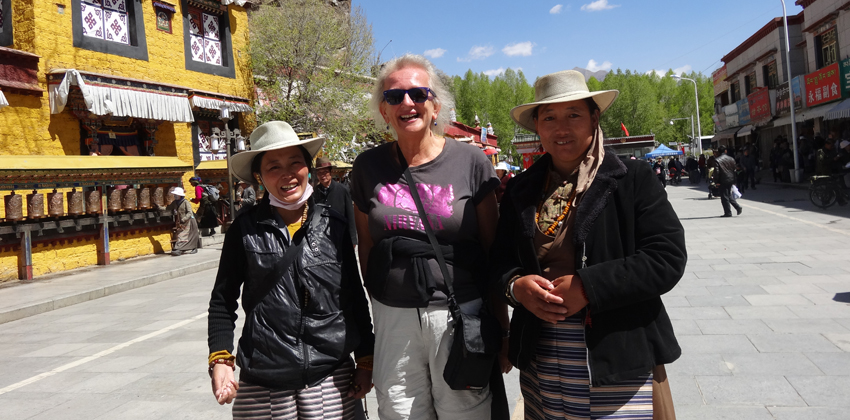
During the two days there, we experienced a range of quintessentially Tibetan sights and sounds. We wandered up to Drepung Monastery, past a couple of indifferent yaks grazing on the dusty dry grass. As we wended our way through halls, temples, courtyards and terraces with wide views past the Buddhist symbols cast in brass, towards the ageless snow capped peaks, we felt almost certain we were being shadowed by a member of the secret police. There was a willowy figure who darted out from behind walls, who emerged from the shadows in a dark foreboding temple as we took hot water to drink in front of large ornate statues of Buddha in varying guises, who popped up just by us again as we started heading down the laneway back towards the chortens in the grounds. Due to periods of political unrest in Tibet, including the self immolation of monks as a form of anti Beijing protest, it is said that agents posing as local civilians, as tourists and even as monks, occasionally shadow visitors to Tibet to ensure that no incitement to insurrection is occurring. Whether this is true or not, the idea that this was even a possibility compounded the sense of drama, already heightened by being present in an occasionally inaccessible region, during our Drepung visit.

We spent a sun lit, blue skied morning climbing up to the heights of the imposing icon of Lhasa, the formidable Potala Palace. We sauntered several times through the multifarious arrays of wares that are traded in Barkhor Bazaar, admiring brass and copperware and shawls and hats but most of all the stoic presence of the local people going about their daily lives on the streets of Lhasa. We "tiptoed" around beds of brilliant tulips in the park across from Potala, tulips which some sceptics had thought to be artificial specimens, planted as part of some Chinese aesthetic propaganda when seen on posters of Potala. We donned wildly flamboyant Tibetan costumes to be photographed with the palace as a magnificently powerful backdrop. Towards sunset, we watched, fully in admiration of the sense of community spirit, as a giant circle of people spanning all ages danced on the square opposite Potala Palace to rhythmic Chinese-Tibetan pop music while the fountains on the square also bobbed and sprayed along in time. At 3.00 in the afternoon, we watched the energetic "debating" monks in the Sera Monastery's courtyard as they practised their readings and understanding of Buddhist doctrine through energetic interaction with partners who indicate through dramatic miming and gesturing whether their responses to questions are correct or not. We stayed in the Mandala Hotel which had a large dining room where breakfast was served, decorated with classic Tibetan motifs and bold colours. Yak butter tea along with more prosaic tea and coffee was available as a breakfast beverage.
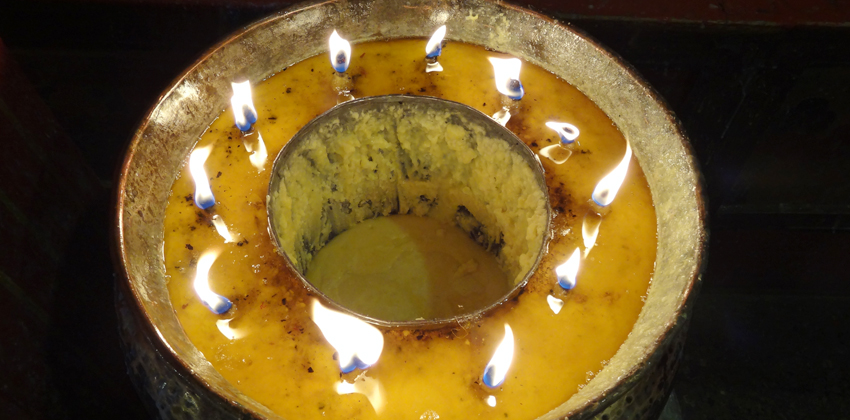
Late in the second day, after using the bathroom, I found I was unable to release the lock on the door to emerge into the dim light of the fading Lhasa afternoon coming through the window of my room. Far be it from me to panic, but I felt I had lurched again from one precarious situation to another. From the initial phase of the "locking in " Lhasa as a fixed point on the itinerary for his trip, I was, for quite some time, facing a chilly future "locked in" in Lhasa, in a green and white ceramic tiled cell. When my intrepid travelling companion was able to successfully address the problem ahead of the Mandala house staff, with a few shouted instructions followed by my fervent manipulations of knobs and latches, I felt the glimmer of hope that I would not be condemned to a life sentence on the tiles in Tibet.
This notwithstanding, the day after tomorrow I will be returning to continue my exploration of this wild and dangerous land. I know that there will be no redress for any interruptions to the proposed itinerary. I know that I am flying on the world's most expensive air route from Kathmandu to Lhasa. I know that my moves may well be monitored by Chinese state officials.
If the visa comes through by tomorrow night, that is.
Julia Ruhl